Browse in the Library:
Jazz Play Along: On Green Dolphin Street (sheet music) by Bronislaw Kaper & Ned Washington
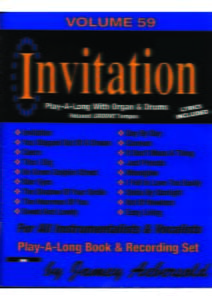
On Green Dolphin Street is one of our 10 Mother Tunes. This famous tune was made for a 1947 movie, “Green Dolphin Street,” and is known for switching back and forth between Latin and swing feels, and for the pedal I’m underneath changing harmonies for the first 7 bars of the A section.
The form is basically ABAB, with the second B being different from the first B. It’s a 32 bar song form, as is so common in the jazz idiom.
“On Green Dolphin Street” was introduced as the main theme of the 1947 MGM film Green Dolphin Street. The movie was based on British novelist Elizabeth Goudge’s 1944 book Green Dolphin Country, published that same year in the United States as Green Dolphin Street.
In 1947, with a string of successful songs and movie scores behind him, Bronislau Kaper was enlisted to write the soundtrack for the production. Suprisingly, the theme was not a hit, even with Ned Washington’s lyrics. It would be a decade before Miles Davis’ recording would establish the composition as a jazz classic.
Sheet Music download
Musical Analysis
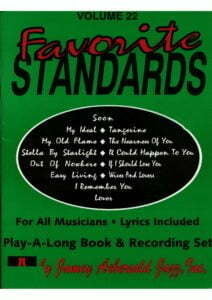
We start from a musical form is A-B-A-C in the key of E flat Major (Eb) with a modulation to G flat Major (Gb) in the B part and rests in the region of the subdominant (II-7) and relative minor (VI-7 ) in part C.
The melody that barely covers an eleventh range (that is, an octave and a half). The melody of section A is characterized by emphasizing the most scalar motifs, with small jumps in the intervals between notes. However, part B is built on arpeggios for more contrast.
I want to highlight the use of the modal interchange of measures 3, 4 and 6 and above all, the use of the PEDAL of TONIC in the first 7 measures of each section A.
Part B and C are based on a succession of II-V-I that goes through different degrees to end with a Turnaround in the original key.
Lastly, I want to highlight measures 1 and 3 of part C, where you can appreciate the use of the 3rd inversion of the minor seventh chord to make a joint degree step in the bass. That in Spanish it would be something like ‘change the bass of a chord to be able to reach the next chord by going down the scale’ does it make sense to you?
In this composition all the chords are either diatonic (that is, they belong to the tonality), or Secondary Dominant, or Substitute Dominant.
Section A contains just a dominant D/C chord (D7), which resolves to Db/C (DbMaj7) a semitone down. Although the bass is not in the fundamental, the encryption and analysis are performed in the same way.
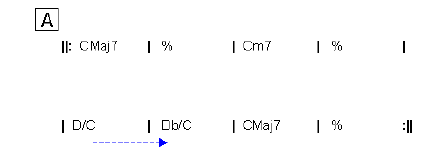
Single chords and chain endings we have: CMaj7, Cm7, and Db/C (DbMaj7). Due to the predominance of the CMaj7 chord, in the first two and last two measures, it is possible to think that the harmonic rhythm is TDDT with two measures per function. Which fits with DbMaj7 acting as the dominant being a modal exchange bIIMaj7, which replaces V7; which, in turn, would precede the D7 as V7/V.
The Cm7 chord will be a mode exchange chord with a minor tonic function, so that although it is not more tense, the harmonic tension already begins to grow in the less weak part of the dominant area.
Thus, attributing its tonal function to each chord, we formalize:

As for the B section, we find two major II-V-I progressions, and an optional dominant like ‘turn around’.

The single chords and chain endings are: CMaj7 and EbMaj7. Harmonic rhythm is obvious in that it is TDTD at two bars per function. It would be possible to fall into the error of thinking that EbMaj7 is the bIIIMaj7, and in turn that Fm7 and Bb7 are the IVm7 and the bVII7; all of them modal interchange. But normally whenever a complete chain of II-V-I, and so on occurs so clearly within the harmonic rhythm, it will be treated as an extratonal modulation imposing the key of Eb Major.
Formalizing:
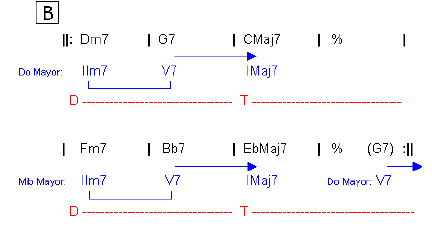
In section C we find two cadences of IIm7b5-V7-Im7, and a longer chain with two dominants and their chained minor seconds. Also a II-V of ‘turn around’.
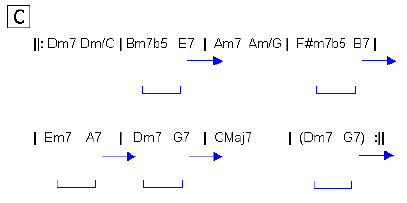
The single chords are Dm7, Am7 and CMaj7, all belonging to C Major, however the non-diatonic chords E7, F#m7b5, B7 and A7 appear. As for the E7, there is no problem considering it as the V/VI. However, we will not consider F#m7b5 and B7 to be the modal exchange #IVm7b5 and V/III.
Instead we will focus on the descending bass line that occurs with the Dm7-Dm/C-Bm7b5 progression. In the key of A minor, it serves to chain the IVm7 with the IIm7b5, and then with the V7 and the Im7. We see that it then repeats itself mimicking the motif with Am7-Am/G-F#m7b5, and then also resolves with B7 and Em7. In such a way that we will consider that the progression has been repeated in another key.
On the other hand, it is easy to see that Em7-A7-Dm7-G7-CMaj7 comply with the formalization IIIm7-V/II-IIm7-G7-IMaj7. It could be said that in the third measure it is modulated to E minor by means of the pivot chord Am7, which is Im7 of A minor (or VIm7 of C Major) and in turn IVm7 of E minor. It is also modulated back to the starting key in the fifth measure with the pivot chord Em7, which is Im7 of E minor and IIIm7 of C Major.
The harmonic rhythm coming from the A section induces the dominant two bars per function. However, the modulation to E minor forces it to be split to one measure per function, and it works like this until the end of the section. If the ‘turn around’ is not played, the dominance of areas is balanced, if it is played, it is restored to the beginning of the new chorus.
Formalizing the last section:

Bronislaw Kaper
Bronislaw Kaper (February 5, 1902 – April 26, 1983) was born in Poland, where he studied classical piano and composition at the Warsaw Conservatory and law at the Warsaw University, as his father wished. Kaper then went to Berlin, where he became involved with a much more jazz-oriented music.
When the Nazis seized power, Kaper went to Paris, where he and his friend Walter Jurmann composed music for films, most of them directed by others fleeing Germany. During the 1940s, Kaper was part of a numerous and distinguished community of exiles, which included Thomas and Heinrich Mann, Bertolt Brecht and Arnold Schoenberg.
The Los Angeles Philharmonic Association created the Bronislaw Kaper Awards for Young Artists, named for Kaper who was on their board of directors for over 15 years.
Ned Washington
Ned Washington (15 Aug 1901-20 Dec 1976) started off in vaudeville and went on to write lyrics for some of the best known songs in movies and big bands: “I’m Getting Sentimental Over You” (1932 with George Bassman) became Tommy Dorsey’s theme song. “When You Wish Upon a Star” (1940 with Leigh Harline) for “Pinocchio” won an Oscar for Best Song. “High Noon (Do Not Forsake Me, Oh My Darlin’” (1952 with Dimitri Tiomkin) was written for the movie “High Noon” and also won an Oscar for Best Song. “Town Without Pity” (also written with Dimitri Tiomkin) became a pop success, sung by Gene Pitney.
He wrote lyrics to “Stella By Starlight” (1946), a very popular jazz standard. Washington was a director of ASCAP from 1957 until 1975 and was inducted into the Songwriter’s Hall of Fame in 1972.
Great Performances:
Instrumental
| ARTIST | DATE | PERSONNEL |
| Urbie Green Septet | 1955.01.12 | Urbie Green (tb), Doug Mettome (tp), Danny Bank (fl, cl, bars), Ike Horowitz (ts, cl, fl), Jimmy Lyon (cel), Oscar Pettiford (b), Jimmy Campbell (d) |
| The Poll Winners | 1957.03.19 | Barney Kessel (g), Ray Brown (b), Shelly Manne (d) |
| Miles Davis Sextet | 1958.05.26 | Miles Davis (tp), Cannonball Adderley (as), John Coltrane (ts), Bill Evans (p), Paul Chambers (b), Jimmy Cobb (d) |
| Bill Evans Trio | 1959.01.19 | Bill Evans (p), Paul Chambers (b), Philly Joe Jones (d) |
| Eric Dolphy Quintet | 1960.04.01 | Eric Dolphy (cl), Freddie Hubbard (tp), Jaki Byard (p), George Tucker (b), Roy Haynes (d) |
| Milt Jackson & Oscar Peterson Trio | 1961.09.15 | Milt Jackson (vib), Oscar Peterson (p), Ray Brown (b), Ed Thigpen (d) |
| Ahmad Jamal Trio | 1961.??.?? | Ahmad Jamal (p), Israel Crosby (b), Vernell Fournier (d) |
| Grant Green Quartet | 1961.12.23 | Grant Green (g), Sonny Clark (p), Sam Jones (b), Louis Hayes (d) |
| Al Grey Septet | 1962.02.19 | Al Grey (tb), Dave Burns (tp), Billy Mitchell (ts), Bobby Hutcherson (vib), Floyd Morris (p), Herman Wright (b), Eddie Williams (d) |
| Sonny Rollins Quartet | 1965.07.08 | Sonny Rollins (ts), Ray Bryant (p), Walter Booker (b), Mickey Roker (d) |
| Joe Henderson & Winton Kelly Trio | 1968.04.21 | Joe Henderson (ts), Wynton Kelly (p), Paul Chambers (b), Jimmy Cobb (d) |
| Lee Konitz Quartet | 1974.09.30 | Lee Konitz (as), Martial Solal (p), David Holland (b), Jack DeJohnette (d) |
| Rhoda Scott & Kenny Clarke | 1977.05.11 | Rhoda Scott (org), Kenny Clarke (d) |
| Herbie Hancock | 1978.10.25 | Herbie Hancock (p) |
| Marian McPartland Trio | 1979.08.11 | Marian McPartland (p), Brian Torff (b), Jake Hanna (d) with Mary Fettig (as) |
| Stan Getz Quartet | 1987.07.06 | Stan Getz (ts), Kenny Barron (p), Rufus Reid (b), Victor Lewis (d) |
| Walter Norris Trio | 1990.09.14 | Walter Norris (p), Neil Swainson (b), Harold Jones (d) |
Vocals
| ARTIST | DATE | PERSONNEL |
| George Shearing Quintet with Nancy Wilson | 1960.07.05 | George Shearing (p), Eddie Costa (vib), Dick García (g), George Duvivier (b), Walter Bolden (d), Nancy Wilson (voc) |
| Mark Murphy | 1961.09.19 | Mark Murphy (voc), Bernie Glow, Ernie Royal, Joe Wilder (tp), Jimmy Cleveland, Urbie Green (tb), Wynton Kelly (p), Barry Galbraith (g), George Duvivier (b), Jimmy Cobb (d) |
| Sarah Vaughan | 1962.02.?? | Sarah Vaughan (voc), Quincy Jones Orchestra |
| Mel Tormé | 1962.07.11 | Mel Tormé (voc), Shorty Rogers Orchestra |
| Sheila Jordan | 1977.08.27 | Sheila Jordan (voc), Arild Andersen (b) |
| George Benson with Count Basie Orchestra | 1990.??.?? | George Benson (voc, g), Bob Ojeda, Byron Stripling, Mike Williams, Sonny Cohn (tp), Bill Hughes, Clarence Banks, Mel Wanzo (tb), Danny Turner (as), David Glasser, Doug Miller, Frank Foster, John Williams, Kenneth Hing, Tim Williams (sax), Carl Carter (p), Charlton Johnson (g), Cleveland Eaton (b), Duffy Jackson (d) |
On the movies:
| MAIN TITLE | YEAR | PERFORMERS |
| Green Dolphin Street | 1947 | Mel Tormé |
| The Prize | 1963 | |
| Zigzag | 1970 | Anita O’Day |
| The Score | 2001 | Cassandra Wilson |
